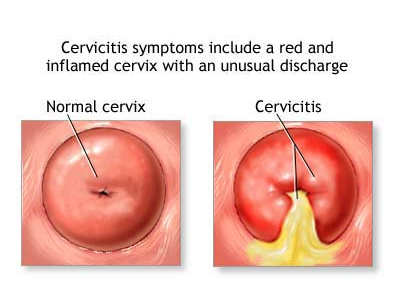Cervicitis refers to an inflammation of the cervix which is the lower, narrow end of your uterus that opens into the vagina. It can result from a number of factors, including infections, chemical or physical irritations, and allergies. For many women with cervicitis, they may not experience any signs or symptoms. When present, the noticeable signs and symptoms are bleeding between menstrual periods and changes in vaginal discharge.

Cervicitis Causes
Cervicitis can be caused by a number of factors, including:
1. Sexually transmitted infections: Cervicitis is most often caused by some bacterial and viral infections through sexual contact. The common sexually transmitted infections (STIs) that can result in cervicitis include chlamydia, gonorrhea, trichomoniasis and genital herpes.
2. Allergic reactions: Cervicitis can be also caused by an allergy, either to contraceptive spermicides or to latex in condoms. A reaction to feminine hygiene products, such as douches or feminine deodorants, also can cause cervicitis.
3. Bacterial overgrowth: An overgrowth of some of the bacteria that are normally present in the vagina (bacterial vaginosis) can cause cervicitis.
Cervicitis Symptoms
For many women with cervicitis, they may not experience any signs or symptoms. One can only know her condition after a Pap test or a biopsy for another condition. When symptoms present, they may include:
Frequent, painful urination
Large amounts of vaginal discharge that's green, brown or yellow and pus-like and that sometimes has an unpleasant odor
Vaginal bleeding after intercourse, not associated with a menstrual period
Painful sexual intercourse
If these symptoms above appear, you should go to see a hospital for a check to confirm the condition.
Cervicitis Diagnosis
Your doctor will likely perform a physical exam to diagnose cervicitis, including:
1. A pelvic exam: During this exam, your doctor checks your pelvic organs for areas of swelling and tenderness. He or she also may place a speculum in your vagina to view the upper part of the vagina and the cervix.
2. A specimen collection: It's a process similar to a Pap test. A small cotton swab or a brush will be used to gently remove a sample of cervical and vaginal fluid. The sample will be sent to a lab to test for infections. Lab tests also may be performed on a urine sample.
Cervicitis Treatment
If your cervicitis is caused by something other than a sexually transmitted infection (STI), there is no need to get treatment. However, if it's caused by STI, both you and your partner should be treated. The usual treatments for cervicitis include:
1. Antibiotics or Herbal medicines like Fuyan Pill for a bacterial infection such as gonorrhea or chlamydia.
2. An antiviral medication, for a viral infection such as genital herpes.
Remember to abstain from sexual intercourse until you're finished with the treatment recommended by your doctor to avoid passing a bacterial infection along to your partner.

